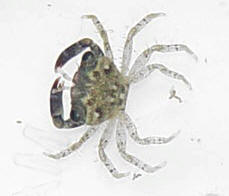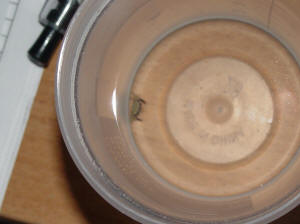|
FAQs about Symbiotic (including Commensal
and not) Crabs
Related Articles: Crabs, Arrow Crabs, Hermit
Crabs,
Related FAQs: Marine Crabs
1, Marine Crabs
2, Marine Crabs 3, Marine Crabs 4, By Species/Group: Arrow Crabs, Emerald Green Crabs, Fiddler Crabs, Pom Pom Crabs, Sally Lightfoots, & FAQs on:
Marine Crab Identification,
Crab Behavior, Marine Crab
Selection, Marine Crab
Compatibility, Marine Crab
Systems, Marine Crab
Feeding, Marine Crab
Reproduction, Marine Crab
Disease, Emerald Green,
Mithrax/Mithraculus Crabs, Micro-Crustaceans, Amphipods, Copepods, Mysids, Hermit
Crabs, Shrimps,
Cleaner
Shrimps, Banded Coral
Shrimp, Mantis
Shrimp, Anemone
Eating Shrimp, Crustacean Identification, Crustacean Selection, Crustacean Behavior, Crustacean Compatibility, Crustacean Systems, Crustacean Feeding, Crustacean Disease, Crustacean Reproduction,
|

|
|
Dear Bob
About 4 months ago I bought a Large
Yellow Acropora frag inside the frag there where two small crabs
( Dark reddish brown with white eyes and about 6mm across the
carapace ) the coral seems fine but I have noticed that the
polyps don't come out all the time when the crabs are
feeding.
My worry is, are they feeding on the
polyps? The reason I ask is I just got a blue Acropora and one of
the crabs was on it. The next day it was back on the yellow one
but the blue one looks patchy.
Mmmm, well, there is documented proof
of some of the commensal crabs being a bit more than just space
hitchhikers. That is, they are known to nibble at living tissue
of their stony coral hosts. But on the positive side, these
crabs, particularly the better-studied Trapeziids, are known to
protect their living coral homes from predators and sediment
accumulation. It's not lost on me that the relationship twixt
these two is so intimate that the crab species aren't found
elsewhere'¦ and even if their symbiotic relationship
trends toward the decapods being a bit parasitic, all the
instances I've encountered in the wild have shown both
parties to be in good health. I suspect that as long as
conditions are propitious for them both (a bit of food provided
for the crabs daily) that your Acroporas aren't in imminent
danger. Reef coral studies have shown that the few polyps lost
are a well-worth trade-off for protection and house cleaning
services. I would leave these two together.
|
Symbiotic crabs 8/17/11
Good morning, crew!
I'm writing today with a question of symbiosis. A few weeks ago, I
purchased a delightful frag of Stylophora from my favorite LFS, and it
has been doing great in my system thus far. In the interest of
providing the most suitable conditions for my first piece of SPS, I
began to read up on crabs of Trapezius variety. Though typically called
"Acropora crabs", will they in fact host a Stylophora as
well?
<Sometimes, yes>
I keep it in a very high flow area, and its polyps are fully extended,
but I know these little guys are great at removing any settled detritus
that the water flow may miss.
I was also curious if it would be safe to add one, in that I would hate
to see it preyed upon by anything in my tank. My fish are two Tomato
Clowns, a Coral Beauty, and a Yellow Watchman (all of which I
understand will leave it alone), but I also have a dozen red legged
hermits, and an emerald crab (about 3/4 in. big). Would it likely take
to my Stylophora quickly enough to avoid the opportunistic gaze of its
crustacean neighbors?
<Mmm, well... symbiotic decapods, including this family do some
damage, and can/have been known to "cross over the line",
become overly predaceous if under-fed, the corals they're
associated w/ become too-stressed. If it were me/mine, I'd only
keep such symbionts on/with corals they were purchased with... in
large, well-established systems. Bob Fenner>
Thanks for the help! As always, it's a pleasure to correspond with
you all.
-Dustin
|
Acro Crab? Possible Trapeziid or Juvenile of
Undetermined Family -- 3/28/10
<Hi Mike, Lynn here today.>
Just found this little crab on a new shipment I just
received.
<Neat! What kind of shipment -- coral (Acropora, Pocillopora,
Stylophora, etc.?), rock, or something else? Where was the
shipment from? What's the size of the crab (carapace
width)?>
Hoping you can confirm whether of not it's an Acro crab?
<That's a tall order! Did it hitchhike in on an Acropora
colony? It could be a coral crab, or it could simply be a
juvenile of some other variety. It has the same large eyes,
roughly triangular carapace, and claw length/shape that you see
in many Trapeziid crabs (family Trapeziidae -- aka 'coral
crabs' or 'coral guard crabs'), but the color/pattern
of the carapace is atypical. That is, it doesn't fit with
what photos I've seen of Trapeziid crabs. The problem is that
there are an awful lot of crab species out there, not all of
which are available as photos on the web or in my research books.
What you have may be a coral crab that in its juvenile phase has
a completely different, more cryptic coloration, than its adult
counterpart. This is not at all unusual in crabs, or other
animals for that matter. Unfortunately, I haven't been able
to find any photos of juvenile Trapeziid crabs for comparison.
Again, there's the distinct possibility that this little crab
could simply be a juvenile from any number of other families.
Juvenile crabs typically have the same large eyes that you see in
Trapeziids. The bottom line here is that unfortunately, all I can
offer are a whole lot of maybes and no concrete answers. Time and
behavior will tell with this little fellow. I can tell you one
thing though. Trapeziids are generally found in the Pacific,
either the Indo-West or tropical Eastern regions. If this little
crab came in on a shipment from say Florida or the Caribbean,
chances are it's not a Trapeziid. Please see the following
link for an example of a juvenile Callinectes sapidus, aka
'blue crab' (see last photo). This is definitely not what
you have (and not a variety of coral crab), but you can see the
similarities:
http://www.serc.si.edu/education/resources/bluecrab/lifecycle.aspx
Here are some examples of coral crabs, along with more info (see
bottom of page):
http://www.chucksaddiction.com/hitchcrabs.html
More info at WWM:
http://www.wetwebmedia.com/Arthropoda/CrustaceanPIX/SWCrabs/Crab%20IDs/SWCrabs3.htm
>
And good/bad?
<Time will tell. This could be a relatively harmless coral
crab, or something else entirely. Since I can't confirm
either way, I'll offer the standard crab warning. That is,
crabs are omnivorous opportunists and scavengers that, if hungry
enough, can and will eat pretty much anything they can grab with
their claws. You have the choice of keeping, observing, and
removing if/when the crab becomes a problem or playing it safe
and putting it elsewhere until you have a better idea what it is
and how much risk it poses to other livestock. Either way, do be
sure to keep it well-fed with meaty scraps of marine origin
(shrimp, clam, squid, fish, etc.) or perhaps sinking
pellets.>
Attached a pic for ID.
<Thanks, he/she certainly appears to be an itty-bitty
thing!>
Thanks!!
<You're welcome!>
Mike
<Take care, LynnZ>
Re: Acro Crab? Possible Trapeziid or Juvenile of
Undetermined Family -- 3/28/10
Lynn,
<Hi Mike>
Thank you for the response.
<You're very welcome.>
He was attached to a "purple monster Acro" from either
the Solomon Islands or Fiji, my supplier only specified vaguely
where all our corals came from, one or the other.
<Thanks, that helps. I just wish that it was enough to be able
to offer you a positive ID! As it stands right now, I'm not
sure what type of crab this is. As was evident in the photo of
the blue crab (see link in previous response), appearance can
change significantly from juvenile to adult. We should know more
as this little fellow matures. Honestly, it could be one of many
different genera (not just in the family Trapeziidae) that are
associated with Acroporids. It could also be an accidental
hitchhiker; that is, not a coral crab at all. Perhaps it was
ousted from its normal habitat during collection and simply took
refuge within the coral's branches.>
I've attached a not so macro pic for a naked eye view as
well. He is tiny, maybe 3-4 mm.
<Yep, that is one small crab!>
Thanks again!
<It was a pleasure! I'm just sorry that I couldn't
give you a more definitive answer.>
Mike
<Take care, LynnZ>
|
  |
|
|

